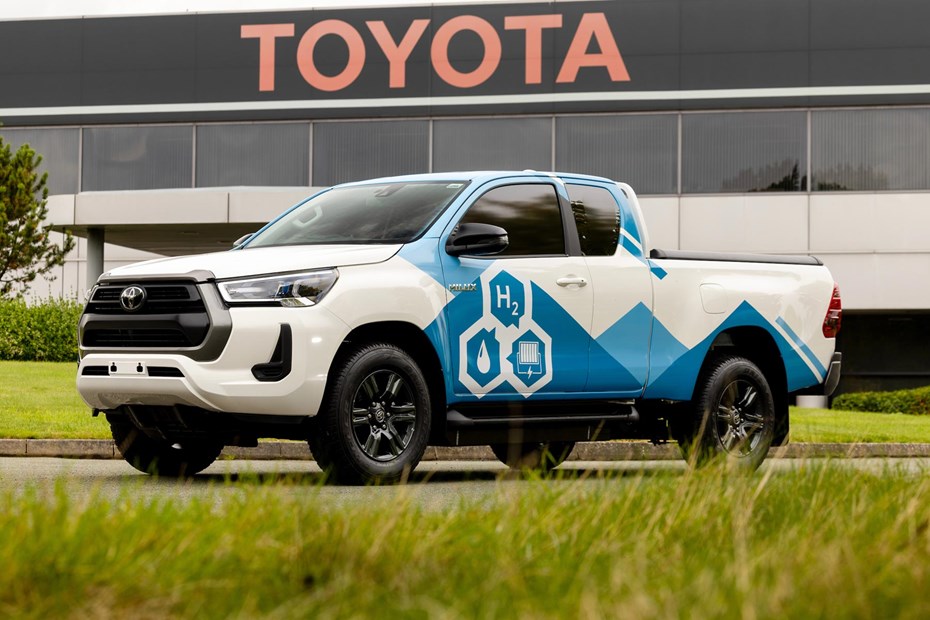A Toyota Hilux hydrogen pickup truck has taken a notable step towards reality with the completion of the first prototype vehicle.
Toyota has created the working vehicle within a remarkably short period of time, having only started the project in July 2022. Only 14 months later the brand has produced the first finished truck, with 10 due to be made by the end of 2023.
Granted, Toyota is starting from an advantaged position, as it already has a production Fuel Cell Electric Vehicle (FCEV) in the form of the Toyota Mirai hatchback. The project, which has been undertaken in partnership with the Advanced Propulsion Centre (APC), takes the rugged Toyota Hilux pickup and slots in the Mirai’s fuel cell stack and hydrogen fuel tanks. Ricardo, ETL, D2H Advanced Technologies and Thatcham Research are the other partners involved in the project.
What is the hydrogen Toyota Hilux capable of?
So far Toyota hasn’t released loads of technical detail on the hydrogen Hilux, saying simply that it features three of the 7.5kg fuel tanks that are fitted in the Mirai, rather than the two that go into the smaller car. This means that, despite being notably bigger and less aerodynamic than the slippery Mirai, the Hilux is still capable of a range of around 365 miles. This is somewhat further than any electric pickup in the UK (of which there aren’t many, granted) is capable of.
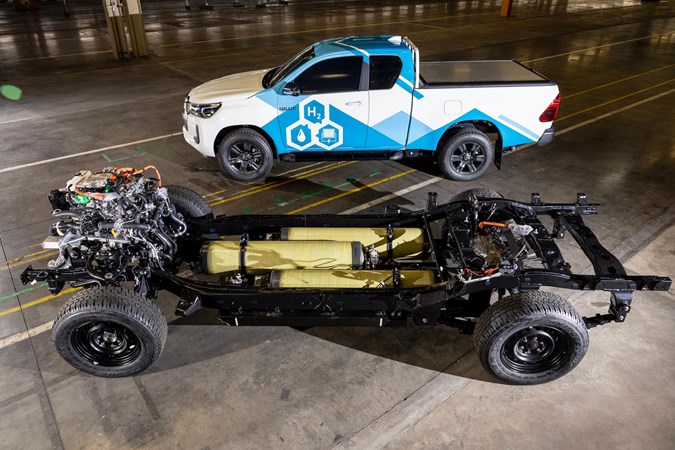
Toyota is keeping details on features such as the payload and dimensions under its hat for now, though. The former is likely to be fairly compromised in this prototype, given the additional equipment that the FCEV Hilux has to come with.
As well as the three fuel tanks there is the fuel cell, which takes up the same space as a conventional diesel engine and fills the under-bonnet area. This charges the battery which then, in part, powers the motor. The latter of these sits under the loading bed which means that there is no room for the battery, which has to go into the loading bay itself.
This means that there is less space for the actual stuff that a pickup carries around as part of its daily duties. At an estimate, you lose about a fifth of the space, but it is worth pointing out that the prototypes are Extra Cab versions of the Hilux. The loading bay is slightly larger than the double cab’s therefore.
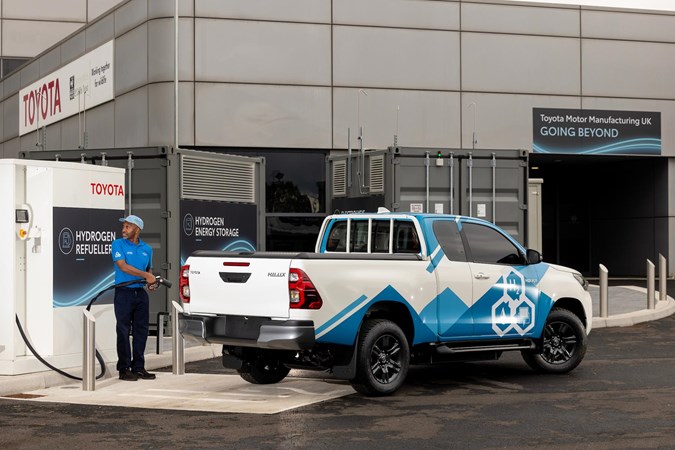
The Extra Cab’s loading bay is 1,808mm long, while the double cab is only 1,525mm, so the useable space is probably about the same as a standard double cab.
What size and shape is the hydrogen Toyota Hilux?
Toyota said it went with the Extra Cab layout in response to customer feedback, as the companies that it will be trialling the vehicle with wanted the ability to carry more than just the two passengers that would fit into a single cab. However, it decided not to go for the full space of a double cab, meaning that there is a bit more room in the back for equipment. Theoretically, all three sizes are possible.
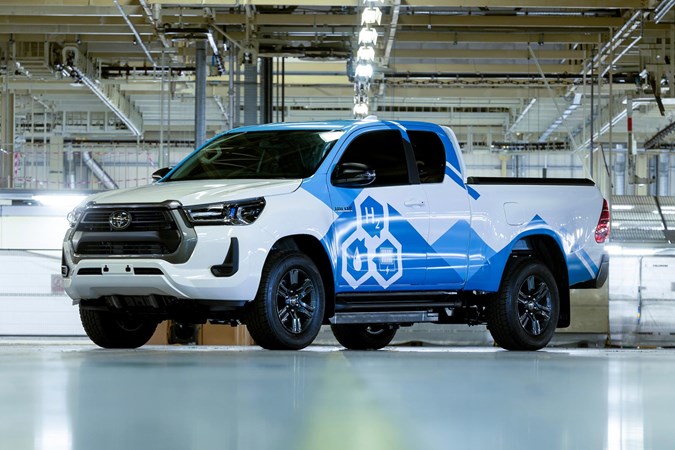
The companies on the trial will have to take things a little carefully when loading the hydrogen Hilux, though, as the battery covering is not flush with the surfaces – it is like having a small box at the front of the bay.
Toyota has also confirmed that the extra space taken up by the hydrogen powertrain means that the trial vehicles will all be rear-wheel drive only – there is no room for the 4x4 system. The tanks under the vehicle also sit on a subframe, which then lowers the ground clearance so it won’t be suitable for any rock-bashing duties.
Will we get a production version of the Toyota Hilux FCEV?
That is potentially the plan, but these 10 vehicles are doing much more than that. Toyota UK MD Agustin Martin said that the immediate goal is to see how they perform and to judge customer interest.
However, they will undeniably also be performing a PR duty. Toyota’s presentations showed that hydrogen is a fuel most often associated with heavy duty and long-range vehicles, such as buses and trucks. Strapping some hydrogen tanks to one of Toyota’s most famous vehicles will raise awareness in a way that a bus won’t.
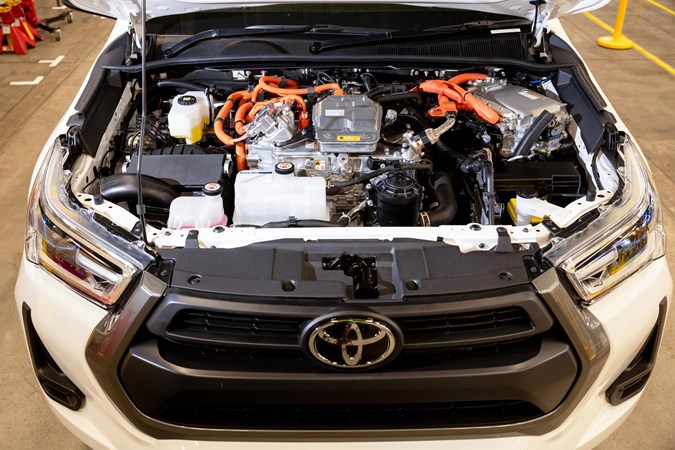
Martin said that light commercial vehicles (LCVs) are certainly part of the plan, though, saying that LCVs are the natural next step. ‘The fact that pickup is a really important market in the UK and that Hilux plays a critical role for us, plus the fact that you have the expertise in the UK in Burnaston and Deeside and the whole thing comes together.’
He pointed to the needs of the potential customers as justification for investigating hydrogen rather than a pure electric pickup, although he didn’t rule out that as an possibility in the future.
‘The options remain open,’ he said. ‘We know the limitations of each of the technologies in theory, we just need to understand in practice what that means.’
He pointed to the needs of customers who are particularly remote and don’t have access to the grid. ‘The pickup market covers such an array of customers. If you think of, for instance, mining. The distance from starting point to working is long and then you need to have the capacity to work when you get there.’
What’s next for the Toyota Hilux hydrogen?
The trials are the next phase, with the 10 necessary trucks due to be completed by the end of 2023. They will then head out to the trial partners in early 2024, following further internal tests.
Just so you know, we may receive a commission or other compensation from the links on this website - read why you should trust us.


